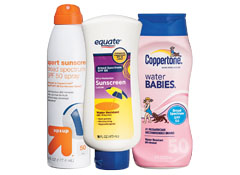CONSUMER REPORTS – We count on sunscreens to protect us from the sun’s harmful UV rays. The higher the SPF the better the protection. Right? Not necessarily. Consumer Reports tested a dozen sunscreens both lotions and sprays and finds there is no guarantee you are getting the level of protection listed on the label.
 In fact, Consumer Report’s tests that measures sunburn protection from UVB rays-what SPF is supposed to tell you-found most of the sunscreens tested provided less protection than the SPF listed.
In fact, Consumer Report’s tests that measures sunburn protection from UVB rays-what SPF is supposed to tell you-found most of the sunscreens tested provided less protection than the SPF listed.
These days you’ll also see the words “broad spectrum” on many sunscreens. Broad spectrum means sunscreens are supposed to protect not just against UVB rays, but UVA rays as well. Both types of rays can cause skin cancer, and UVA rays can wrinkle and age your skin.
Consumer Reports’ sunscreen tests performed both on people and on test plates coated with sunscreen found some products offer better protection than others for both UVA and UVB rays.
Top-rated is a spray from Target, Up and UP Sport broad spectrum SPF 50. Spray sunscreens are convenient, but the risks of inhaling them are still being studied. So Consumer Reports does not recommend spraying children. And does not recommend spraying directly on your face. Also be aware that sprays are flammable. So wait for the spray to dry before going near an open flame. If you prefer a lotion, Consumer Reports named one from Walmart a Best Buy. It’s Equate Ultra Protection Sunscreen Broad Spectrum SPF 50. It offers better protection than several sunscreens tested that cost much more.
With any sunscreen, Consumer Reports says that you should apply sunscreen 15 to 30 minutes before you head into the sun and reapply it after you take a swim or every two hours.
SOURCE: Consumer Reports: Don’t get burned by your sunscreen

Comments are closed.